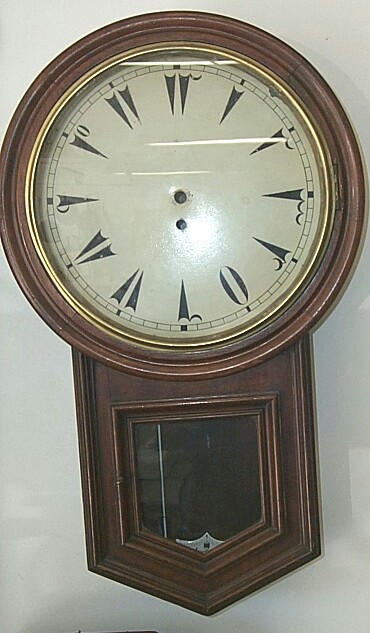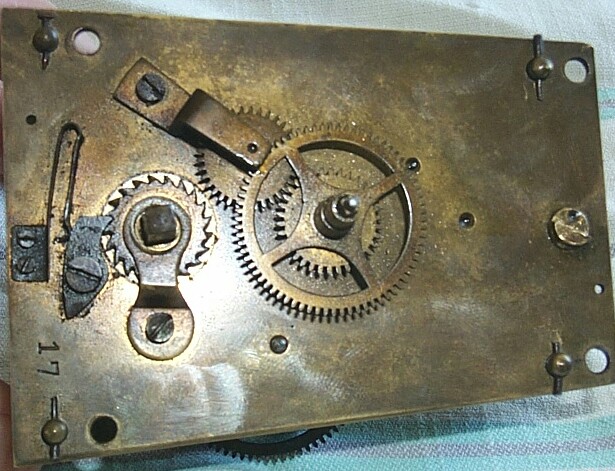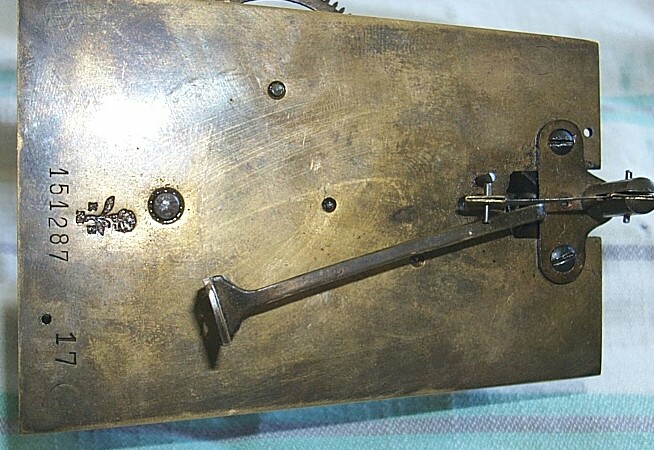
| WWT Shows | CLICK TO: Join and Support Internet Horology Club 185™ | IHC185™ Forums |

|
• Check Out Our... • • TWO Book Offer! • |
Welcome Aboard IHC185™  Internet Horology Club 185
Internet Horology Club 185  IHC185™ Discussion Site Main Page
IHC185™ Discussion Site Main Page  Horological Discussions, Questions and Answers
Horological Discussions, Questions and Answers  Clocks, Including 400-Day Discussions
Clocks, Including 400-Day Discussions  What can you tell me about this Clock?
What can you tell me about this Clock?
 Internet Horology Club 185
Internet Horology Club 185  IHC185™ Discussion Site Main Page
IHC185™ Discussion Site Main Page  Horological Discussions, Questions and Answers
Horological Discussions, Questions and Answers  Clocks, Including 400-Day Discussions
Clocks, Including 400-Day Discussions  What can you tell me about this Clock?
What can you tell me about this Clock?Go  | New Topic  | Find-Or-Search  | Notify  | Tools  | Reply to Post  |  |
| IHC Member 250 |
What can you tell me about this clock? where it was made, what that dial is all about? about how old, the case is well made and looks just like our schoolhouse clock cases and has little windows each side. Many thanks, Sam  | ||
|
| IHC Member 250 |
Here is a photo of the movements front  | |||
|
| IHC Member 250 |
Here is the movements backside.  | |||
|
Looks like it was make for the turkish market based on the dial. Here is a artical I pilfered...credit goes to Brian Loomes. Collecting Antique Clocks Turkish Market Clocks One special type of clock made by certain clockmakers of the past was what we today call a 'Turkish Market' clock. This term can be a bit confusing for the beginner, as the clocks were neither Turkish nor had they anything to do with a market. They were in fact made by certain makers, principally London-based ones, who built up good trading connections with the Middle East. A similar situation existed with a few London clockmakers who had a special trading contact with e.g. Spain, the best-known of those probably being a London clockmaker working in the 1760s, who signed those clocks he destined for the Spanish market 'Diego Evans, Borsa Real, Londres' in place of his usual 'David Evans, Royal Exchange, London'. Occasional clocks are seen signed by a London maker 'a Londres', probably intended for a destination in France Clocks made for the Middle Eastern market are usually signed in the ordinary way, such as 'George Clarke, London' without any attempt at writing London in Turkish script. The reason this demand for clocks existed in the Middle East was, I am told by those who know these things, that prayers were required to be performed in mosques at specific times, and reliable clocks were therefore essential to ensure that this could be done. Holiday makers who visit present-day Turkey are often struck at the presence of eighteenth-century London-made clocks still there and still performing the same function. Presumably clockmaking in those areas was less advanced or less reliable than in London, whose clockmakers throughout the eighteenth and nineteenth centuries were generally regarded as the best in the world. In those days 'Turkey' probably meant the Turkish or Ottoman Empire, which covered a large part of the Middle East. A Turkish Market clock is unmistakable because its numerals are visibly quite different from English ones, as can be seen by the clocks illustrated here. Turkish Market clocks are ( dare I say always ?) two-handers. The numerals used are clearly intended to denote the minutes and hours and have that 'Eastern' look about them, though I am told they are not the same as any numerals actually used in eastern notation. It does not take long to figure out that 0 represents 5, a 1 with one upper curl to the right represents 1, 1 with two curls means 2, 1 with three curls 3, and so on. In fact whatever numerals were used it is very obvious to anyone by the position of the hands just what time is represented. . Examples are met with of all kinds of clocks and watches too with 'Turkish' numbers, obviously made for export to the Middle East. Longcase clocks made for the Turkish market are not all that common; bracket clocks even less so. Perhaps the most common type of Turkish Market clock is the lantern clock, and these were made with the same type of verge-pendulum movement as English examples of an earlier period. Verge lantern clocks in England were probably eclipsed in favour of the more accurate long pendulum form by about 1720, examples later than that usually being limited to more traditional rural backwaters. In fact the verge lantern clock was a far more easily portable item than a long pendulum version, and it was probably for that reason that the verge lantern clock continued for some considerable period in England after even the long pendulum with its more accurate anchor escapement was introduced. The verge lantern continued to be made in those types of English clocks which were intended to be easily portable, such as the small travelling alarm types. The thirty-hour longcase clock with its long pendulum did all that a long-pendulum lantern clock could do, and did it more conveniently. So that by the time the long pendulum was being used on lantern clocks, lantern clocks themselves were all but extinct anyway. Turkish Market clocks however retained the verge escapement, even though it was already obsolete in favour of the more accurate anchor, and it was probably for that very reason, namely the ease of transporting (and of course ease of shipping over great distances to the purchaser). Verge escapement clocks with their short pendulum are also much less fussy about being set level or 'in beat' than long pendulum clocks, and that may also have been a factor important when sending such items long distances to their eventual destination, where they might be set up by someone inexperienced at setting a clock in beat. Lantern clocks made for this Middle Eastern market seem mostly to date after about 1720 and as late as about 1780, most dating from the 1760s and 1770s, a time when traditional British lantern clocks were already extinct. The majority have arched dials, like a miniature longcase dial and quite unlike a British lantern clock dial. Most have two hands - those for the British market had as single hand. There is therefore, apart from the highly-distinctive numbering style, no danger of confusing one with the other. Turkish market lantern clocks therefore break almost all the specifications we have for a British lantern clock - being deliberately made at a time when true British lantern clocks had ceased production, using a verge escapement that was obsolete in all but bracket clocks, with a different form of dial from a British model and with two hands against the normal single hand of a British example. And yet we still call them lantern clocks! This is because the movement is exactly like the traditional British lantern clock movement of the late seventeenth century. Seen without the dial you would be hard pressed to tell one from the other.. Certain makers in London specialised in Turkish Market clocks, as well as making their normal British Market models. Well known for these export clocks were London makers Isaac Rogers, Henton Brown, George Clarke, George Prior and Markwick Markham, though there were others, all members of the Clockmakers' Company of London and they signed their clocks quite proudly on a boss in the arch with their normal nameplates - as in fact they were not only proud to do but were obliged by law to do. Sometimes one sees a clock for the Turkish market signed in writing which looks 'Turkish' but is just pseudo-Turkish, such as the one in plate ..... where the 'maker's' surname is engraved to look a bit like a Turkish name, here 'Constantine'. I am not sure why this was done. It was perhaps one way the true maker could conceal his identity, and similar practices were indulged in by certain provincial clockmakers, who were trading in British markets without legal consent. Perhaps a clockmaker working in London without the sanction of the Clockmakers' Company could hide behind such fictitious signatures. Since these clocks were made to be exported, it is surprising that such a number are to be found still in this country. Did they never leave in the first place? Or were they perhaps brought back from the Middle East as curiosities by British travellers of the past? In terms of value a verge escapement (i.e. short pendulum) Turkish Market lantern clock is not as valuable by any means as a British verge lantern clock, even if signed by a London reputable maker. But then it would not be nearly as old as the 'British Market' equivalent, and, while many British verge lanterns were later converted to anchor escapement for greater accuracy, the same does not apply to Turkish Market ones. A British lantern clock with original verge escapement is a scarce thing. Turkish market lantern clocks are uncommon, but when they do turn up they virtually always have their original verge escapements. Copyright © 2003 Brian Loomes | ||||
|
| IHC Member 250 |
Thanks so much for the great info about that clock Mr. Russell. | |||
|
Sam, Please call me Stephen, and if I can be of assistance again, just let me know. It is what 185 is all about.I am sure more will post better information shortly. | ||||
|
Hi Sam, Your clock was made by a German maker R Schnekenburger in the late 1800s. Mun C.W. | ||||
|
| Powered by Social Strata |
| Your request is being processed... |
|
Welcome Aboard IHC185™  Internet Horology Club 185
Internet Horology Club 185  IHC185™ Discussion Site Main Page
IHC185™ Discussion Site Main Page  Horological Discussions, Questions and Answers
Horological Discussions, Questions and Answers  Clocks, Including 400-Day Discussions
Clocks, Including 400-Day Discussions  What can you tell me about this Clock?
What can you tell me about this Clock?
 Internet Horology Club 185
Internet Horology Club 185  IHC185™ Discussion Site Main Page
IHC185™ Discussion Site Main Page  Horological Discussions, Questions and Answers
Horological Discussions, Questions and Answers  Clocks, Including 400-Day Discussions
Clocks, Including 400-Day Discussions  What can you tell me about this Clock?
What can you tell me about this Clock?©2002-2025 Internet Horology Club 185™ - Lindell V. Riddle President - All Rights Reserved Worldwide

